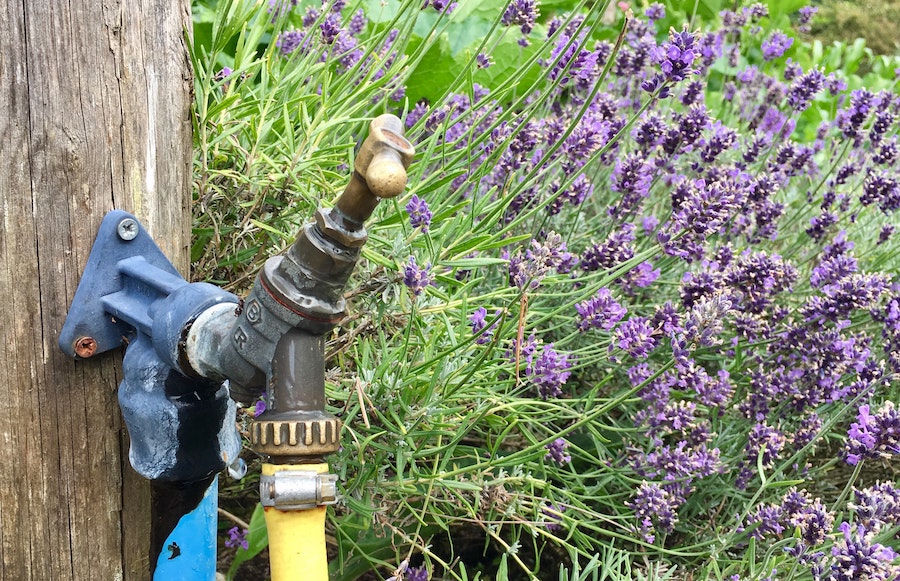Step away from the hosepipe: 6 tips to help your garden thrive through a dry summer
With summers seemingly getting hotter, we need to garden with a new perspective. One way to approach this is by working with climate change, says dry garden expert Olivier Filippi, whose classic book, The Dry Gardening Handbook, has just been republished.
“Happily, by working with our changing climate rather than against it there are lots of pluses for the gardener: The opportunity to grow the beautiful mounds of silver-leaved, scented plants that thrive in these conditions; less maintenance because there’s less weeding and very little watering; and the delight of watching your garden evolve by adopting a more relaxed approach,” says Filippi.
It’s tempting to think that you can help your plants survive summer droughts by giving them good growing conditions, with lots of water and a rich bed of potting compost. But for dry-climate plants, nothing could be further from the truth.
“Many dry-climate plants positively prefer stony, poor, well-drained soil, and repeated watering simply encourages shallow rooting which leaves the plants vulnerable to drought as well as harbouring fungal diseases,” Filippi notes.

Many plants prefer dry conditions
Here are six drought-defying tips from Filippi, including his top plants for surviving a dry British summer…
1. Choose survivors

Mexican fleabane will grow in dry conditions
Instead of going to the garden centre and choosing whatever looks nice and is in flower, start by looking around your neighbourhood and seeing which plants thrive naturally with little attention.
Are your streets overflowing with that pretty pink daisy (Mexican fleabane) growing out of walls and steps? Are your neighbours’ gardens filled with mounds of catmint flowering generously through May and June?
These are your local survivors. Encourage them to grow in your garden, learn from the conditions they like and develop your planting around them.
2. Check the roots when you buy

This healthy-rooted plant is ready for planting out
Initially, a pot-grown plant puts out roots that grow freely in all directions. Then when the roots hit the sides of the pot they start to grown inwards, twisting around until they have created a hard knot.
If you plant this rootball in your garden, the plant will have a tough time sending roots downwards as if it ‘remembers’ being constrained by the pot. Only small secondary roots grow and it cannot anchor itself in the soil.
The plant will struggle in drought conditions where it’s important for plants to reach deep down into the soil to find moisture. Don’t buy rootbound plants from the garden centre or nursery.
3. Ensure good drainage

Plants like lavender need really good drainage
Dry-climate plants have adapted to soil conditions that may look harsh but which suit them perfectly. Establish your plants in stony, poor, well-drained soil. Although it may appear counter-intuitive and against all you have read about gardening, these conditions are what dry-garden plants need.
What they can’t cope with – and many a lavender or cistus has been lost from this – is rich, heavy, compacted soil that forms puddles in which their roots suffocate.
4. Plant in autumn

Plant in autumn to give your plants the best chance
This allows your plants the longest possible time to establish before the summer months and potential for drought takes hold. Plants put on a surprising amount of root growth during the autumn months before it gets cold and early in spring.
Although you may not see much foliage growth above ground in the first few months, the root system will be developing and branching to make a strong foundations and give it the best possible chance of survival.
5. Water wisely

Create a trench around the plant before watering initially
Water your newly established plants in the first year after planting only, and water infrequently but copiously by filling the large watering basin you have excavated around it.
The water must form a patch of moisture deep in the ground seeping through to well below the rootball to draw the roots downwards. Here the moisture lasts longest without evaporating. Conversely, using the sprinkler every evening to give your plants a small quantity of water every evening makes them more sensitive to drought.
They form a thin carpet of roots just below the surface where evaporation is greatest. They come to rely on you for water every evening and will never learn to look after themselves.
After the first year, forget the hosepipe – once well established with deep roots, drought-tolerant plants will not need any additional irrigation.
6. Choose tough plants for a hot, dry summer

Californian poppies are great for dry gardens
These include: Ballota acetabulosa (Greek horehound); Catananche caerulea (cupid’s dart); Centranthus ruber (red valerian); Erigeron karvinskianus (Mexican fleabane); Eschscholzia californica (California poppy); Euphorbia myrsinites (broad-leaved glaucous spurge); Gaura lindheimeri (white gaura); Nepeta racemosa (catmint); Perovskia ‘Blue Spire’ (Russian sage); Salvia sclarea (clary sage); Santolina chamaecyparissus (cotton lavender), and Verbena bonariensis (Argentinian vervain).

The Dry Gardening Handbook: Plants And Practices For A Changing Climate by Olivier Filippi is published by Filbert Press, priced £40. Available now.
The Press Association
Latest posts by The Press Association (see all)
- The best ways to boost your immune system as cold temperatures hit - January 5, 2025
- The Osmonds star and ‘beloved husband and father’ Wayne Osmond dies aged 73 - January 2, 2025
- What screenings are available on the NHS to detect cancer early? - January 2, 2025
- Help your grandchildren make the most of Big Schools’ Birdwatch - January 1, 2025
- Veteran radio star Johnnie Walker dies aged 79 - December 31, 2024




















